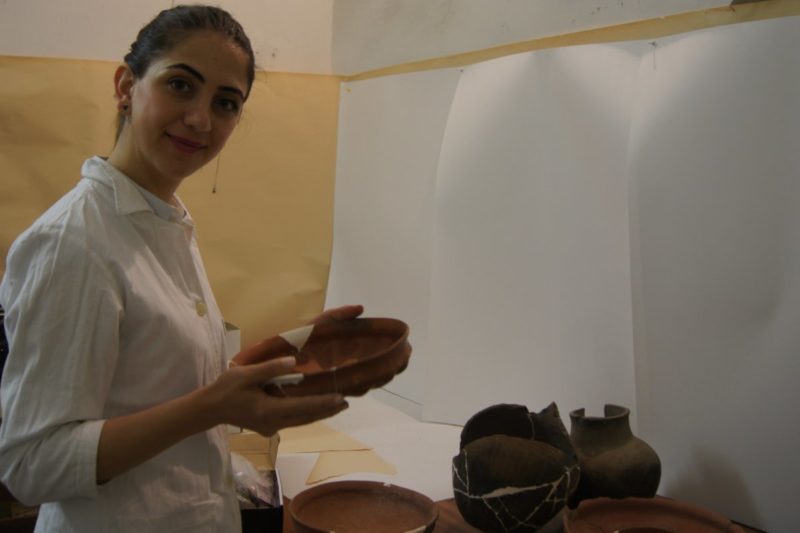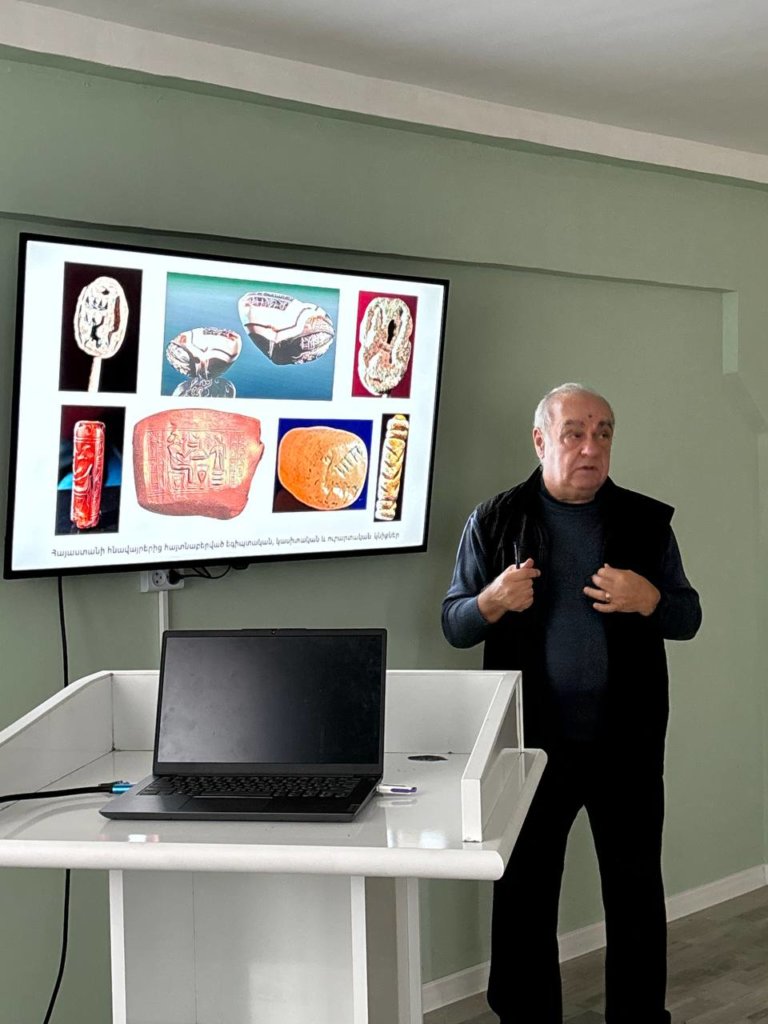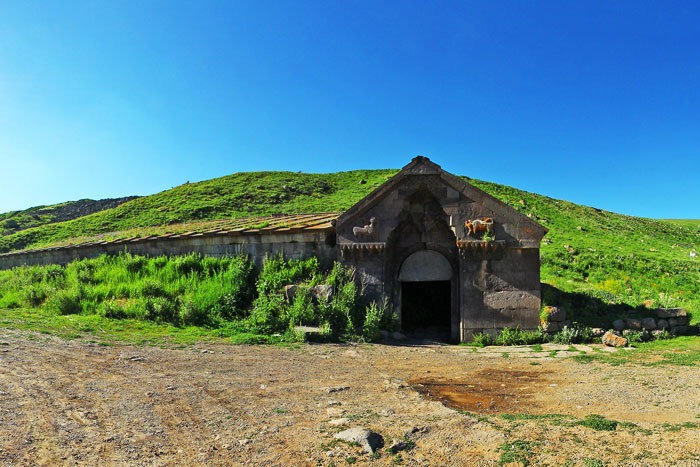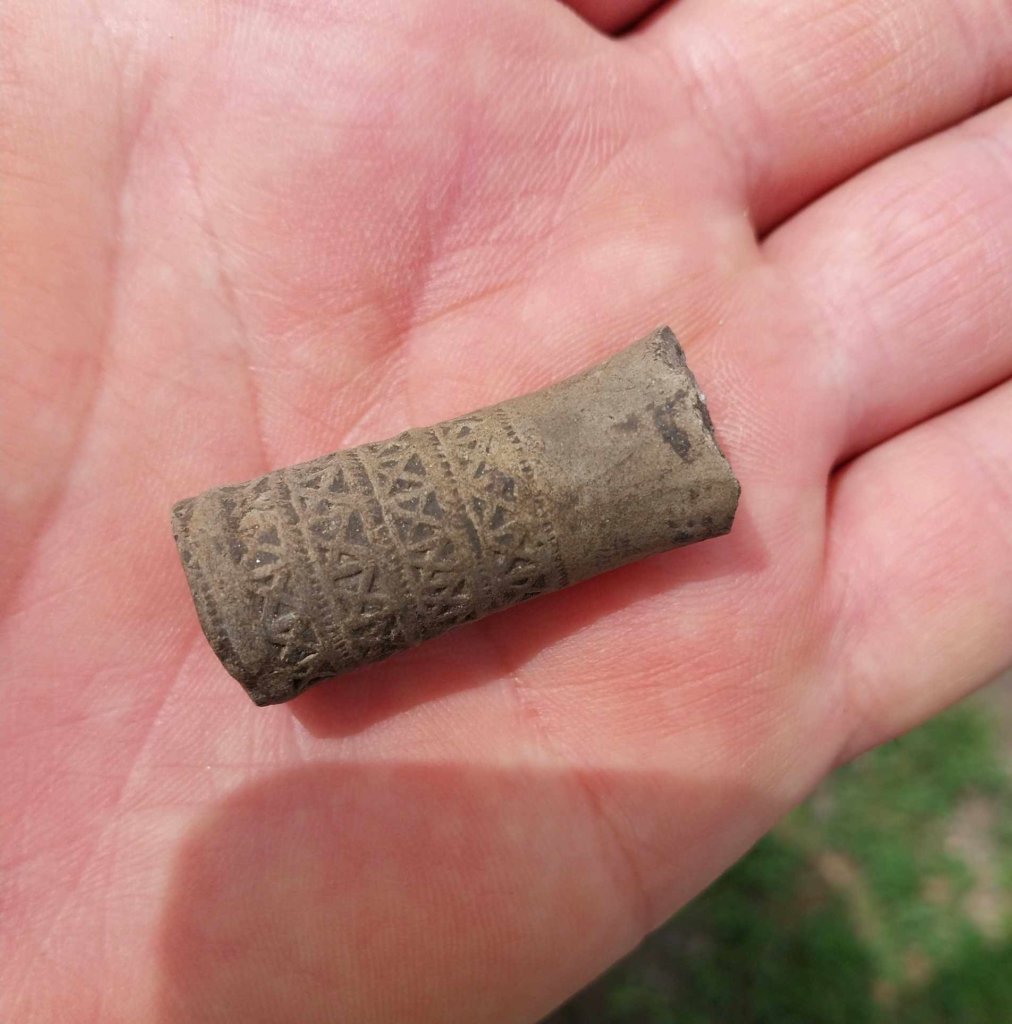Stocks, both preliminary and primary, are considered as one of the most interesting sections of any institution responsible for the preservation of cultural heritage. Only those who are familiar with all works and responsibilities related to the stocks can tell about the incredibly exciting world they get to work in, where past and the present come together, where one gets a chance to interact with partially and fully preserved cultural heritage coming from ancient times.
Despite the strict restriction on entering the stocks of the Service for the Protection of Historical Environment and Cultural Museum-Reservations, SNCO, we were provided with an opportunity to be an exception. Materials of the preliminary stocks are being kept in two rooms.
Lusine Aleksanyan is the keeper of the preliminary stock. The young employee, who is specialized in archeology, after receiving the stock, turned to the important work of studying and classifying the cultural pride she was provided with (i.e. Early and Middle Bronze ages, Iron age, Urartu, Middle ages,etc. )
With my request, Lusine carefully opens the boxes from the shelves and takes out the archeological material: a saltcellar, an earthenware, fragments of amphora, etc.
In this small room, materials discovered during excavations in Jrahovit from 1960-1975 are being kept. The head of the archeological expedition did not submit them to the stocks by saying that there is a need for cleaning, classification, registration, and numbering of materials.
“There is a wide range of archeological material starting from Kur-Araks ending with Middle Ages, discovered during the excavation process. Last year, I submitted 1300 items from Kur-Araks to the primary stock. They were in a fragmentary condition. I washed them, cleaned them up, and classified them along with my co-workers from recovery laboratories. After the registration process, the materials replenished the archeological stock,” Lusine said.
Working with an archeological material means having a maximum amount information about the items as much as possible. As Lusine honestly puts it, “I tried to collect as much information on Jrahovit as possible, in order to, first of all, get a full image and understanding of the Monument itself. And in terms of excavations, I tried to examine the diary of Emma Khanzadyan, the head of the archeological expedition, in order to identify and fully understand all the perceived information on the subject.”
As Lusine was destined to find out, there was piece of incomplete information in Emma Khanzadyan’s diary about the materials, and it was impossible to fulfill and get complete information on the subject. But one particular material was an exception. Lusine takes out more than a dozen pieces of fragments from the box and tries to get a complete picture out of them.
“We already have part of the amphora, and if we bring together the fragments and pieces, there is a chance that we would get a complete item. Also, there is a possibility that other items from the preliminary stock would become complete items as well.”
Lusine Aleksanyan does not have a special feeling towards a particular item from the stock, but she says that she likes the medieval saltcellar a lot.
In the preliminary stock of the organization, a number of items discovered during excavations in the hill of Lchap are also being kept: the calculator from the Soviet era, the typewriter, the radio set, and the camera.
Lusine, one by one, takes them out of the box, cleans the dust off of them, and says that after registration, she will transfer them to the Ethnography stock. The description of the items would be given by the ethnographers.
As a specialist in archeology, she participated in excavations organized in Erebuni, Karmir Blur, and Metsamor.
“The most impressive one was in Erebuni. The setting of the wall was opened, and at first we thought that it was a round shelter. After, we found out that that was not the case. In 2013, we carried out excavations in some parts of Karmir Blur. As a result, the tomb field began to open,” says the archeologist.
While speaking about the excavations organized in the territory of Metsamor, the archeologist proudly says that the very first golden item that she herself found was a half-moonlike hanger from Metsamor.
Another treasure of the preliminary stock is 171 items found in the territory of Zorats Karer.
Under the supervision of the secretary scientist of the Service for the Protection of Historical Environment and Cultural Museum-Reservations, SNCO, Ashot Piliposyan, and the deputy director Karen Pahlevanyan, for a couple of years, excavations are being carried out in the territory of Zorats Karer. All the discovered materials such as crocks were cultivated and registered by Lusine, who, after giving descriptions to them, sent them to the stocks with the help of the excavating archeologist.
Also, there are many enormous materials, items, and fragments in the stock that are so heavy that one would be unable to lift them from the ground.
“It’s a piece of a pitcher from middle ages that I did not get an opportunity to study yet. This is the first time I am moving it,” says Lusine with a smile on her face.
Her eyes are shining when we are walking to the next small stock room full of archeological materials. As she remembers, a few years ago, during a construction work, a resident of Hatsarat community, Gegharkunik province, came across a cultural strip. The archeologist of the SNCO, after studying the space, found a huge number of interesting materials: a crock, an amphora, jewelry, plates, and metal items coming from the times of Urartu. Lusine gave the description to the items and numbered them.
As we continue to study the items in the room, a staff member from the primary stock comes in. For a while, the conversation stops, because as usual, a number of items such as a bracelet, fragments of daggers and crocks are being handed to the primary stock. As I found out, the future responsibility for the items was on the shoulders of the staff of recovery laboratories.
When I turned the recorder off, my interviewee got even more honest. She said that her dream is to have an opportunity to be the first person receiving the material immediately after excavations so that she would be the one to tell all the perceived information to others.
And as dreams have a habit of coming true, one day, the dream of archeologist-stock keeper Lusine Aleksanyan will become a reality as well…







